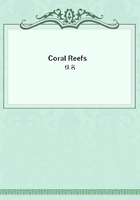
第79章
Nearly all that is known of this group is derived from the labours of D'Entrecasteaux and Bougainville: the latter has represented one continuous reef ninety miles long, parallel to the shore, and in places as much as ten miles from it; coloured pale blue. A little distance northward we have the LAUGHLAN Islands, the reefs round which are engraved in the "Atlas of the Voyage of the 'Astrolabe'," in the same manner as in the encircled islands of the Caroline Archipelago, the reef is, in parts, a mile and a half from the shore, to which it does not appear to be attached; coloured blue. At some little distance from the extremity of the Louisiade lies the WELLS reef, described in G. Hamilton's "Voyage in H.M.S.
'Pandora'" (page 100): it is said, "We found we had got embayed in a double reef, which will soon be an island." As this statement is only intelligible on the supposition of the reef being crescent or horse-shoe formed, like so many other submerged annular reefs, I have ventured to colour it blue.
SOLOMON ARCHIPELAGO.
The chart in Krusenstern's "Atlas" shows that these islands are not encircled, and as coral appears from the works of Surville, Bougainville, and Labillardiere, to grow on their shores, this circumstance, as in the case of the New Hebrides, is a presumption that they are fringed. I cannot find out anything from D'Entrecasteaux's "Voyage," regarding the southern islands of the group, so have left them uncoloured.--MALAYTA Island in a rough MS. chart in the Admiralty has its northern shore fringed.--YSABEL Island, the N.E. part of this island, in the same chart, is also fringed:
Mendana, speaking (Burney, volume i., page 280) of an islet adjoining the northern coast, says it is surrounded by reefs; the shores, also of Port Praslin appear regularly fringed.--CHOISEUL Island. In Bougainville's "Chart of Choiseul Bay," parts of the shores are fringed by coral-reefs.--BOUGAINVILLE Island. According to D'Entrecasteaux the western shore abounds with coral-reefs, and the smaller islands are said to be attached to the larger ones by reefs; all the before-mentioned islands have been coloured red.--BOUKA Islands. Captain Duperrey has kindly informed me in a letter that he passed close round the northern side of this island (of which a plan is given in his "Atlas of the 'Coquille's' Voyage"), and that it was "garnie d'une bande de recifs a fleur d'eau adherentes au rivage;" and he infers, from the abundance of coral on the islands north and south of Bouka, that the reef probably is of coral; coloured red.
Off the north coast of the Solomon Archipelago there are several small groups which are little known; they appear to be low, and of coral-formation; and some of them probably have an atoll-like structure; the Chevallier Dillon, however, informs me that this is not the case with the B. de CANDELARIA.--OUTONG JAVA, according to the Spanish navigator, Maurelle, is thus characterised; but this is the only one which I have ventured to colour blue.
NEW IRELAND.
The shores of the S.W. point of this island and some adjoining islets, are fringed by reefs, as may be seen in the "Atlases of the Voyages of the 'Coquille' and 'Astrolabe'." M. Lesson observes that the reefs are open in front of each streamlet. The DUKE OF YORK'S Island is also fringed; but with regard to the other parts of NEW IRELAND, NEW HANOVER, and the small islands lying northward, I have been unable to obtain any information. I will only add that no part of New Ireland appears to be fronted by distant reefs. I have coloured red only the above specified portions.
NEW BRITAIN AND THE NORTHERN SHORE OF NEW GUINEA.
From the charts in the "Voyage of the 'Astrolabe'," and from the "Hydrog.
Memoir," it appears that these coasts are entirely without reefs, as are the SCHOUTEN Islands, lying close to the northern shore of New Guinea. The western and south-western parts of New Guinea, will be treated of when we come to the islands of the East Indian Archipelago.
ADMIRALTY GROUP.
From the accounts by Bougainville, Maurelle, D'Entrecasteaux, and the scattered notices collected by Horsburgh, it appears, that some of the many islands composing it, are high, with a bold outline; and others are very low, small and interlaced with reefs. All the high islands appear to be fronted by distant reefs rising abruptly from the sea, and within some of which there is reason to believe that the water is deep. I have therefore little doubt they are of the barrier class.--In the southern part of the group we have ELIZABETH Island, which is surrounded by a reef at the distance of a mile; and two miles eastward of it (Krusenstern, "Append."
1835, page 42) there is a little island containing a lagoon.--Near here, also lies CIRCULAR-REEF (Horsburgh, "Direct." volume i., page 691, 4th edition), "three or four miles in diameter having deep water inside with an opening at the N.N.W. part, and on the outside steep to." I have from these data, coloured the group pale blue, and CIRCULAR-REEF dark blue.--the ANACHORITES, ECHEQUIER, and HERMITES, consist of innumerable low islands of coral-formation, which probably have atoll-like forms; but not being able to ascertain this, I have not coloured them, nor DUROUR Island, which is described by Carteret as low.
The CAROLINE ARCHIPELAGO is now well-known, chiefly from the hydrographical labours of Lutke; it contains about forty groups of atolls, and three encircled islands, two of which are engraved in Figures 2 and 7, Plate I.